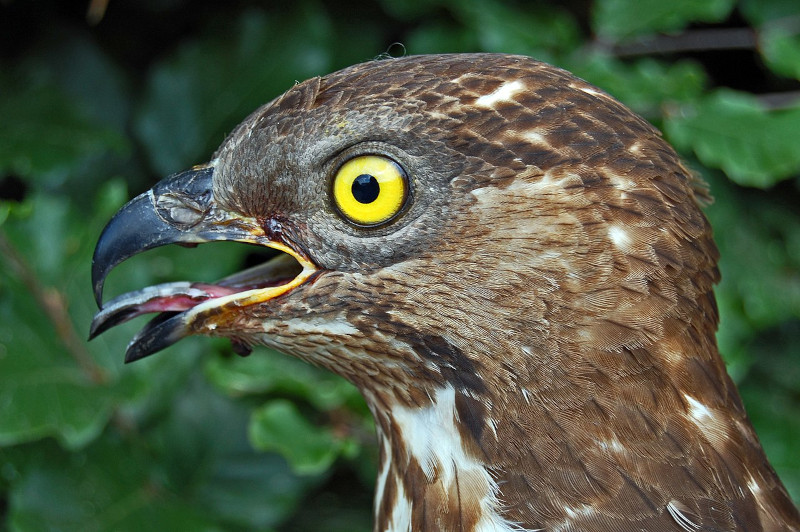European Honey Buzzard Facts
- This remarkable bird most frequently goes by the partially deceptive common name of the European Honey Buzzard across most of its range. Yet, it also has alternate names, as well. These include such relatively simple terms as the pern and common pern.
- Among scientists, however, such as researchers, it’s perhaps best known by its official name. That’s the relatively easy to pronounce term of Pernis apivorus. Regardless of the title one chooses to use to refer to it, though, it remains a fascinating variety of raptor.
- Like many species in its region, it owes its formal name to the respected Swedish zoologist, Carl Linnaeus. That’s because the well known researcher accomplished the first known official recognition of the animal as a separate and distinct species, in 1758.
- Despite its common name, this product of Nature and evolution isn’t closely related to buzzards. In point of fact, it’s more closely related to kites, of two other genera. The bird’s further currently placed in the Family Accipitridae by ornithologists.
- Fortunately, the European Honey Buzzard appears to be maintaining a population base that’s both stable and sufficient. This also seems to hold true throughout the entirety of its range. The IUCN therefore lists it as Least Concern on its Red List.
- The avian does face some potential threats to its continued existence. These, however, consist of the same factors facing most species around the world. Habitat loss poses a potential danger, of course. Climate change likely forms its greatest threat, though.
Related Articles
Long Eared Owl
European Honey Buzzard Physical Description
The fabulous European Honey Buzzard quickly impresses those who encounter it. Unlike some species, however, it does so for several reasons. While simple physical size isn’t the only factor on any list of such reasons, it’s likely the one many people notice most.
The bird stands out in this manner since it’s actually larger than many related species, such as the similarly-named common buzzard. It further measures so in terms of both body length and wingspan. This surprising trait applies overall to individuals of both genders.
Also regarding genders, like many creatures, the bird displays the physiological characteristic of sexual dimorphism. In its specific case, though, the trait manifests itself in two separate ways. This fact distinguishes it from many related species in yet another way.
In terms of sheer size, the female of the species attains a slightly greater size than her male counterpart. Overall, however, individuals average about 20 – 24 in (52 – 60 cm) in body length. Wingspan, meanwhile, averages approximately 53 – 59 in (135 – 150 cm).
The second gender-based physical difference appears in terms of the coloring of the plumage. In general, this consists of varying shades of dark and light brown. Males, though, develop a bluish-gray head, while that of the female remains brown, like the rest of the body.
The European Honey Buzzard also has a longer neck than most of its relatives. The head’s comparatively small, though the beak’s powerful. It also has a longer tail than most. It’s further evolved talons that are comparatively straight, also setting it apart from its peers.
- Kingdom: Animalia
- Phylum: Chordata
- Class: Aves
- Order: Accipitriformes
- Family: Accipitridae
- Genus: Pernis
- Species: P. apivorus
European Honey Buzzard Distribution, Habitat, and Ecology
Fortunately, the fabulous European Honey Buzzard evolved as native to a relatively broad section of the globe. Even more, however, it also engages in seasonal migrations, like many other birds. This only serves to increase the territory it appears in to even greater extents.
Firstly, this stunning raptor lives its warmer seasons across the majority of the continent of Europe. There, it only avoids the most northerly regions. Secondly, though, it migrates to more tropical regions in Africa. It thereby effectively inhabits two separate ranges.
Like many varieties of avians, though, it also displays a fairly extensive adaptability regarding its choice of precise habitat within those broader ranges. In the more pristine ecosystems it makes appearances in, it displays a strong preference for areas of woodlands.
It nonetheless shows little reservation about making its home in areas with a moderate human presence. In fact, in many parts of Europe, it’s frequently spotted in the vicinity of plantations of various types. It also sometimes nests in larger parks with sufficient trees.
The dazzling European Honey Buzzard also evolved in another manner that sets it apart from many others. That manifests in its diet. That’s because this particular bird is a highly specialized feeder. Even here, though, the raptor distinguishes itself yet again.
Less commonly, however, it sometimes consumes small reptiles, mammals, and even other birds. It primarily consumes both the larvae and the nests of hornet and wasps, however. It additionally represents the only known predator of the dreaded Asian Hornet!
Species Sharing Its Range
Check out our other articles on 5 Indigenous Hawaiian Species, Mountain Apollo, McMurdo Dry Valleys, Texas Blind Salamander, New Zealand Giraffe Weevil, Porbeagle, Melnik Earth Pyramids

